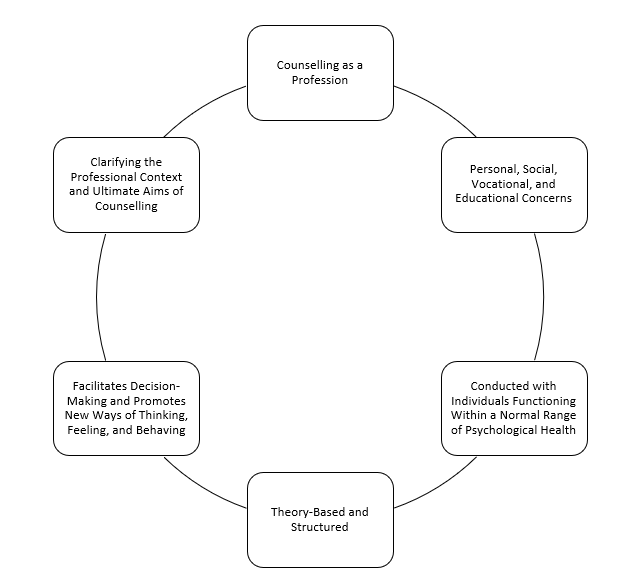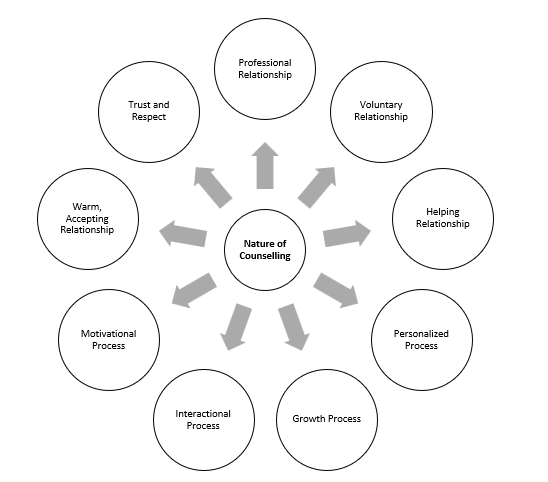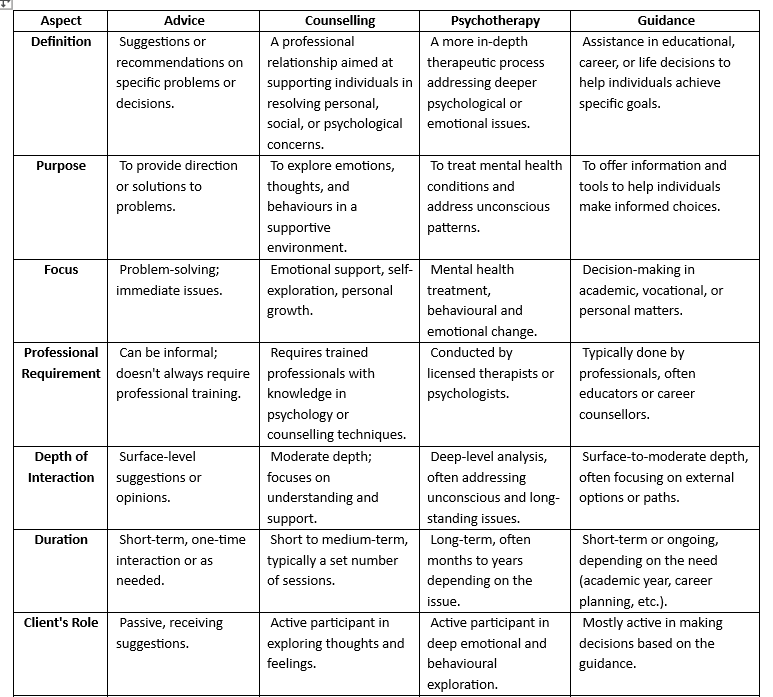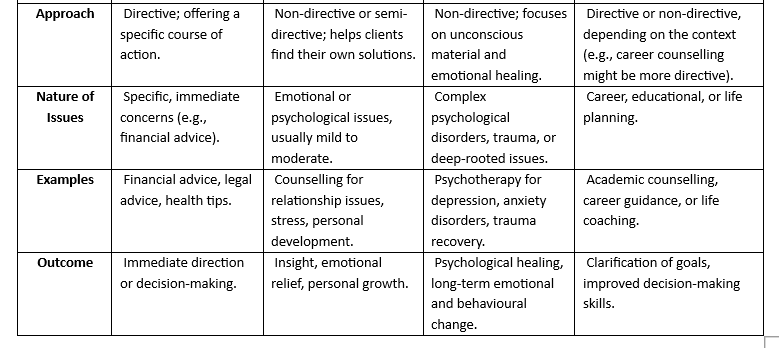Contents
Introduction
Counselling is a multifaceted process that plays a critical role in the mental health and well-being of individuals. It encompasses various definitions and theories, each contributing to our understanding of its nature and purpose.
Definitions of Counselling
Biswalo’s Perspective
Biswalo (1996) defines counselling as a process that assists individuals in accepting and utilizing information and advice to address their problems effectively. This definition underscores the importance of self-acceptance and the practical application of advice. According to Biswalo, empowers clients to confront their issues rather than evade them.
British Association for Counselling and Psychotherapy
The British Association for Counselling and Psychotherapy (2002) elaborates that it occurs in a private and confidential environment where clients can explore their difficulties, emotional distress, or dissatisfaction with life. This definition emphasizes the safe space that counselling provides, which is essential for open and honest communication.
American Counselling Association
The American Counselling Association (2010) provides a consensus definition, stating, “Counselling is a professional relationship that empowers diverse individuals, families, and groups to accomplish mental health, wellness, education, and career goals.” This definition highlights the collaborative nature of counselling and its focus on empowerment and goal attainment.
Key Characteristics of from the American Counselling Association (ACA)
The American Counselling Association (ACA) defines counselling as a distinct professional field, emphasizing its role in addressing a wide range of personal, social, vocational, and educational concerns. The ACA’s definitions frequently highlight several critical aspects of it that help clarify its professional context and objectives.
Counselling as a Profession
Counselling is recognized as a legitimate, regulated profession that requires extensive training, ethical adherence, and competency. According to the ACA, it is not just an informal helping relationship but a formalized discipline grounded in scientific research and practical applications. Counsellors must typically possess at least a master’s degree, licensure, and ongoing professional development to practice. The ACA establishes rigorous standards for training and ethics, ensuring that practitioners are competent in addressing clients’ diverse needs. This formal professional identity distinguishes it from other forms of support, such as peer support or informal advice-giving.
A study by Remley and Herlihy (2016) emphasizes the need for a well-defined professional identity, noting that professional counsellors undergo standardized education and adhere to ethical guidelines to provide competent care. The Council for Accreditation of Counselling and Related Educational Programs (CACREP) also sets accreditation standards to ensure that counsellors are adequately prepared for their role.
Personal, Social, Vocational, and Educational Concerns
Counselling addresses a broad spectrum of issues, including personal growth, interpersonal relationships, career guidance, and academic concerns. The wide-ranging applicability of it highlights its flexibility in addressing human problems at different life stages. Whether clients are seeking to resolve personal dilemmas, improve their social relationships, or enhance vocational and educational goals, it provides structured support tailored to these specific areas.
Gore et al. (2018) explores how counselling in educational settings, for example, plays a vital role in academic achievement by helping students develop resilience and coping strategies. Similarly, vocational counselling is essential in career decision-making processes, guiding individuals through career transitions or workplace challenges.
Conducted with Individuals Functioning Within a Normal Range of Psychological Health
Counselling typically serves individuals who are not experiencing severe psychopathology but instead face typical life challenges, such as stress, relationship difficulties, or career transitions. It is often distinguished from psychotherapy, which focuses more intensively on treating diagnosable mental health disorders. While it may involve mental health concerns, its focus is on improving well-being, enhancing functioning, and addressing life challenges that fall within a range of normal psychological functioning.
According to Hackney and Cormier (2019), the primary goal of counselling is to help individuals cope with common life stressors, not necessarily to treat severe mental illness. This distinction positions of it as an intervention that facilitates personal growth and problem-solving in a less clinical context.
Theory-Based and Structured
Counselling is rooted in theoretical frameworks that guide the intervention process. The ACA outlines that counsellors use evidence-based theories, such as cognitive-behavioural therapy, person-cantered therapy, or existential therapy, to inform their practice. These theories provide a structure for assessing clients’ issues, developing treatment plans, and guiding the counselling sessions. The reliance on established theories ensures that it is systematic, predictable, and based on research-supported methods.
Research conducted by Corey (2020) highlights that counsellors use structured techniques based on theoretical models to foster client change. For example, cognitive-behavioural theory (CBT) structures sessions around identifying and challenging negative thought patterns, while person-cantered therapy emphasizes providing a supportive, non-judgmental environment.
Facilitates Decision-Making and Promotes New Ways of Thinking, Feeling, and Behaving
A core goal of counselling is to empower individuals to make informed decisions and adopt healthier patterns of thinking, feeling, and behaving. Counsellors work collaboratively with clients to explore issues, generate solutions, and develop skills that promote psychological resilience and adaptability. This facilitation is not directive; instead, counsellors provide guidance and support that help clients arrive at their own solutions, promoting autonomy and self-efficacy.
A meta-analysis by Cooper and McLeod (2021) highlights that counselling interventions consistently promote positive changes in cognitive, emotional, and behavioural domains. Clients who engage in it often report greater self-awareness, improved decision-making skills, and an enhanced ability to manage emotions and relationships.
Clarifying the Professional Context and Ultimate Aims of Counselling
These key characteristics—being a profession, addressing various life concerns, serving individuals within the normal psychological range, relying on theory, and promoting decision-making—are crucial in clarifying the nature of counselling. It aims to provide structured, evidence-based support to help individuals manage everyday challenges, promote well-being, and facilitate personal growth. It operates within an ethical framework and ensures that interventions are grounded in established psychological theories, thereby professionalizing and standardizing the support provided to clients.

Characteristics of Counselling
The ACA’s definition of counselling underscores its professional identity, theoretical grounding, and practical applications in addressing a wide range of life issues. It is a structured, theory-based approach that facilitates decision-making and enhances individuals’ capacity to cope with life’s challenges. The evidence supporting these characteristics further strengthens the argument that it is an essential, recognized profession aimed at fostering personal growth and improved functioning within normal psychological parameters.
Nature and Goals of Counselling
Understanding the nature of counselling involves examining its characteristics and the goals it seeks to achieve. Each of the following elements plays a vital role in shaping the counselling process and ensuring it remains effective in addressing clients’ concerns.
Professional Relationship
Counselling is a formal, professional relationship in which trained counsellors guide clients through emotional, psychological, and sometimes behavioural challenges. This relationship is distinct from other forms of interpersonal support, as it requires professional training, licensure, and adherence to ethical standards. The counsellor’s expertise provides the structure needed to help clients navigate complex issues while maintaining confidentiality and mutual respect. Carl Rogers, a pioneer of client-cantered therapy, emphasized that the foundation of counselling is built on respect and unconditional positive regard, fostering trust and a therapeutic alliance that promotes growth and healing (Rogers, 1961).
Rogers (1961) highlighted that the counsellor’s role is to provide a non-directive, supportive environment where clients feel empowered to explore their thoughts and emotions. This professional rapport is integral to effective therapy, allowing clients to engage deeply in the process.
Voluntary Relationship
Counselling is inherently a voluntary process, meaning that clients actively seek out the service to address their personal issues. This voluntary nature is critical, as it implies that clients are motivated to engage and benefit from the counselling process. Unlike other interventions, such as court-mandated therapy, where participation may be compulsory, voluntary counselling allows for a collaborative, client-cantered approach, where the client remains in control of the process and direction.
Corey (2016) emphasizes that the success of it is often dependent on the client’s willingness to participate, as clients who voluntarily engage in therapy tend to be more motivated and open to change.
Helping Relationship
Counselling is recognized as a helping relationship, where the counsellor’s primary goal is to support clients in resolving their personal concerns. This relationship is characterized by the use of evidence-based interventions tailored to meet the client’s individual needs. By focusing on one-on-one, face-to-face interactions, counsellors can provide personalized support and apply techniques such as cognitive restructuring, active listening, and empathy to foster emotional healing.
Egan (2014) describes the helping relationship as an interactive and structured process where counsellors provide support that allows clients to develop problem-solving skills and emotional resilience. This relationship is designed to empower clients to address their specific challenges.
Personalized Process
Counselling recognizes that each individual’s needs and experiences are unique, which is why the process is highly personalized. Counsellors tailor their approach, techniques, and goals based on the client’s specific context, issues, and aspirations. This individualized focus allows for more effective outcomes because it takes into account the complexity and diversity of human experiences, ensuring that the interventions align with the client’s specific circumstances.
Yalom (2005) underscores the importance of personalization in therapy, as each client’s concerns and life circumstances are different. Tailoring therapy to meet these unique needs helps ensure that clients feel heard and understood, which enhances the overall therapeutic experience.
Growth Process
Counselling is not merely about resolving immediate problems but also about fostering long-term personal growth. It encourages clients to build on their strengths, develop resilience, and enhance their coping mechanisms. The goal is to enable clients to not only overcome current challenges but also to grow into more self-aware, emotionally balanced individuals, equipped with the tools to handle future difficulties.
Prochaska and Norcross (2019) explore it as a growth-oriented process, where clients are encouraged to cultivate self-awareness, emotional intelligence, and problem-solving skills. The emphasis on personal development fosters long-term improvements in well-being.
Interactional Process
The counselling process is dynamic and interactional, cantering on meaningful dialogue between the counsellor and client. Through this interaction, clients can explore their thoughts, emotions, and behaviours, leading to greater self-understanding and insight. The counsellor helps facilitate this process by asking probing questions, reflecting on emotions, and guiding clients toward new perspectives.
Rogers (1961) describes the interactional nature of counselling as a core component of therapeutic change. The counsellor-client dialogue encourages deeper reflection, helping clients to understand and resolve their issues in a safe, supportive environment.
Motivational Process
A key goal of counselling is to motivate clients toward positive change. By fostering a supportive environment, counsellors help clients recognize their potential, clarify their goals, and develop strategies for change. Motivational counselling techniques, such as motivational interviewing, are used to increase clients’ intrinsic motivation to achieve personal growth and make life changes that align with their values and desires.
Miller and Rollnick (2013) developed motivational interviewing as a counselling approach that emphasizes collaboration and autonomy. By empowering clients to find their own reasons for change, counsellors can increase engagement and promote sustainable behavioural and emotional transformation.
Warm, Accepting Relationship
A warm, accepting environment is crucial in counselling, as it helps clients feel safe to express their innermost thoughts and emotions. This atmosphere of non-judgmental acceptance fosters openness, enabling clients to explore difficult or painful issues. The counsellor’s role is to provide empathy and unconditional positive regard, which Carl Rogers described as essential to facilitating personal growth and self-acceptance (Rogers, 1961).
Rogers (1961) proposed that empathy, congruence, and unconditional positive regard are the core conditions necessary for effective counselling. These elements help build a therapeutic environment where clients feel understood and accepted, allowing them to engage fully in the counselling process.
Trust and Respect
Counselling relationships are built on mutual trust and respect, essential components for a successful therapeutic process. Trust allows clients to feel secure in sharing personal information, while respect ensures that the counsellor validates the client’s experiences without judgment. This trust and respect create a foundation for a safe and productive therapeutic alliance, enabling clients to explore issues more openly.
Yalom (2005) highlights that trust and respect are foundational elements of the counselling relationship. Without these, clients may withhold important information or resist exploring deeper emotional issues, hindering the progress of therapy.
The nature of counselling is multifaceted, encompassing elements of professionalism, voluntary engagement, personalized support, and a focus on growth. The helping relationship established in counselling is interactive, motivational, and built on trust and respect, ensuring that clients feel supported in their journey toward personal growth. These characteristics work together to create a therapeutic environment where clients can explore their challenges, develop new insights, and achieve meaningful change.

Nature and Goals of Counselling
Differences Between Guidance and Counselling
Guidance is a broader term that encompasses various services, including counselling. Butter (1996) distinguishes between two phases in the helping process-
- Adjustive Phase- This phase focuses on social, personal, and emotional problems, aligning closely with counselling.
- Distributive Phase- This phase emphasizes educational, vocational, and occupational concerns, which is more aligned with guidance.
The key differences are-
- One-Way vs. Two-Way Exchange- Guidance often involves a one-way exchange of information, where the advisor provides direction. In contrast, counselling involves a two-way exchange, allowing clients to explore their issues collaboratively with the counsellor (Corey, 2016).
- Nature of Interaction- Guidance is generally instructive and educational, while counselling is facilitative, enabling clients to understand and resolve their own problems (Egan, 2014).
Differences Between Advice and Counselling
Advice is typically given without the necessity of professional training. It often involves providing opinions or recommendations based on one’s experience. Key characteristics of advice include-
- One-Way Process- The person providing advice does so without an interactive dialogue with the seeker.
- Persuasive Nature- Advice often includes persuasive elements, where the advisor may push for a particular course of action (Corey, 2016).
In counselling, the approach is significantly different-
- Professional Training Required- Counsellors are trained professionals who understand the psychological implications of the issues being discussed (Miller & Rollnick, 2013).
- Interactive Process- Counselling encourages a dialogue where clients are empowered to explore their options and arrive at decisions based on their goals and values (Egan, 2014).
For instance, if a student is unsure about career choices, advice may involve telling them which career to pursue based on job market trends. Conversely, it would explore the student’s interests, values, and goals to help them identify a suitable career path.
Differences Between Psychotherapy and Counselling
Counselling is generally regarded as a short-term intervention focused on specific emotional or situational challenges. For example, a child who has lost a parent or a student struggling with exam failure might benefit from it. The primary aim is to help clients cope with their current issues and enhance their emotional well-being (Corey, 2016).
Psychotherapy, on the other hand, tends to be a long-term treatment approach aimed at deeper psychological issues. It often deals with patterns of behaviour and emotional disturbances that have persisted over time. Psychotherapy may be more appropriate for individuals dealing with complex mental health conditions such as depression, anxiety disorders, or trauma (Yalom, 2005).
The key differences-
- Duration- Counselling is often short-term, while psychotherapy may span several months or years (Prochaska & Norcross, 2019).
- Focus- Counselling addresses immediate emotional distress, whereas psychotherapy delves into underlying patterns and issues (Corey, 2016).
Counselling is a vital process that plays a significant role in supporting individuals as they navigate their emotional and psychological challenges. Its definitions, characterized by various professional organizations, highlight its collaborative, empowering, and personalized nature. By understanding its nature and goals, and distinguishing it from guidance, advice, and psychotherapy, we can better appreciate the importance of it in fostering mental health and well-being.

Advice vs Guidance vs Psychotherapy

Advice vs Guidance vs Psychotherapy
As mental health continues to gain attention globally, the significance of it as a profession will only grow, making it essential for counsellors to remain committed to ethical practices, continuous learning, and the pursuit of professional development. The future of it will undoubtedly involve integrating new technologies and methods, yet the core principles of empathy, trust, and support will remain at its foundation.
Reference for Counselling
Biswalo, P. (1996). Guidance and counselling in schools and colleges. Dar es Salaam University Press.
British Association for Counselling and Psychotherapy. (2002). What is counselling? Retrieved from [BACP website](https://www.bacp.co.uk)
Butter, G. (1996). Guidance and counselling: A comprehensive approach. New Delhi: Deep & Deep Publications.
Cooper, M., & McLeod, J. (2021). Client preferences and therapy outcomes: A meta-analysis. Journal of Counselling Psychology, 68(4), 410-420.
Corey, G. (2016). Theory and practice of counselling and psychotherapy. Cengage Learning.
Egan, G. (2014). The skilled helper: A problem-management and opportunity-development approach to helping. Cengage Learning.
Gore, P. A., Jr., Leuwerke, W. C., & Kelly, K. R. (2018). Counselling in educational settings. SAGE Publications.
Hackney, H., & Cormier, S. (2019). The professional counsellor: A process guide to helping. Pearson.
Miller, W. R., & Rollnick, S. (2013). Motivational interviewing: Helping people change. Guilford Press.
Prochaska, J. O., & Norcross, J. C. (2019). Systems of psychotherapy: A transtheoretical analysis. Oxford University Press.
Remley, T. P., & Herlihy, B. (2016). Ethical, legal, and professional issues in counselling (5th ed.). Pearson.
Rogers, C. R. (1961). On becoming a person: A therapist’s view of psychotherapy. Houghton Mifflin.
Yalom, I. D. (2005). The theory and practice of group psychotherapy. Basic Books.

Please guide on complete syllabus of this subject for MA 3 rd sem as per SPPU.
We will update it soon.
I think this is a great article! I have been thinking about counselling for a while now and I think it would be a great way to help me deal with some of the issues I’m facing. I’m glad I found this article
THANK YOU!!!
I think this is a great article! I have been thinking about counselling for a while now and I think it would be a great way to help me deal with some of the issues I’m facing. I’m glad I found this article
My name is Magalu Danagi and I am from Papua New Guinea. I am working for City Mission PNG, an organization that started 30years ago.
City Mission deals with youths from the streets of Port Moresby the capital city of PNG, youths who are hopelessly roaming the streets and getting involved in petty crimes. The youths are aged from 18yrs to 25yrs.
City Mission PNG tries to rehabilitate this youth with Life Skills Training, Literacy and Numeracy. It provides shelter, food and other basic needs. It also provides counselling, case management and case study.
I have done my Diploma in Community service work with Australia Pacific Technical College. We did touch a little bit on counselling and am very interested in doing counselling as it fit with my work here At City Mission PNG
What I have read is a step forward in counselling and I hope either to do more study on counselling or more information on counselling to contribute to my work with City Mission PNG and my country.
Thank you
Good thank you